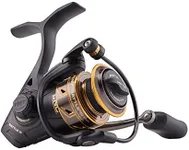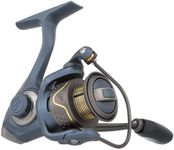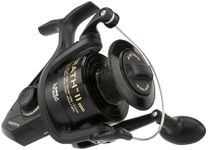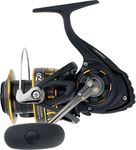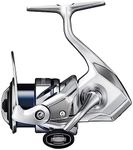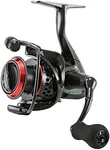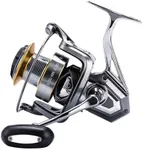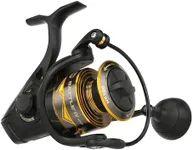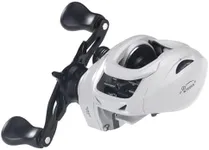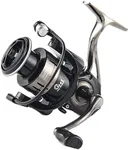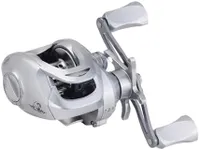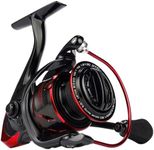Buying Guide for the Best Salmon Spinning Reels
Choosing the right salmon spinning reel can greatly enhance your fishing experience. The right reel will provide you with the necessary strength, smoothness, and durability to handle the powerful runs and jumps of salmon. When selecting a spinning reel, it's important to consider several key specifications to ensure you get the best fit for your needs. Here are the key specs to look at and how to navigate them.Reel SizeReel size refers to the physical size of the reel and its line capacity. This is important because it determines how much line you can hold and the overall balance of your fishing setup. Reel sizes are typically categorized by numbers such as 2500, 3000, 4000, etc. For salmon fishing, a reel size between 3000 and 5000 is generally recommended. A 3000 size reel is lighter and suitable for smaller salmon or lighter tackle, while a 5000 size reel offers more line capacity and strength for larger salmon and heavier tackle. Choose a reel size based on the size of the salmon you are targeting and the type of fishing you plan to do.
Gear RatioThe gear ratio of a spinning reel indicates how many times the bail rotates around the spool with one turn of the handle. This is important because it affects the speed at which you can retrieve your line. Gear ratios are expressed as a ratio, such as 5.2:1 or 6.2:1. A lower gear ratio (e.g., 4.9:1) provides more torque and is better for reeling in larger, stronger fish like salmon. A higher gear ratio (e.g., 6.2:1) allows for faster retrieval, which can be useful when you need to quickly bring in your line. For salmon fishing, a moderate gear ratio around 5.2:1 to 6.2:1 is often a good balance between power and speed.
Drag SystemThe drag system on a spinning reel controls the amount of resistance a fish feels when it pulls on the line. This is crucial for tiring out strong fish like salmon without breaking your line. A smooth and reliable drag system helps prevent sudden line breaks and allows you to control the fish more effectively. Drag systems are usually rated by their maximum drag pressure, measured in pounds. For salmon fishing, look for a reel with a maximum drag pressure of at least 15-20 pounds. This will give you enough stopping power to handle the powerful runs of salmon.
Ball BearingsBall bearings in a spinning reel reduce friction and provide smooth operation. The number of ball bearings can affect the reel's smoothness and durability. Reels with more ball bearings generally offer smoother performance. However, the quality of the bearings is also important. For salmon fishing, a reel with at least 4-6 high-quality ball bearings is recommended. This will ensure smooth casting and retrieval, which is essential when dealing with the fast and powerful movements of salmon.
Line CapacityLine capacity refers to the amount of fishing line that a reel can hold, usually specified in yards for different line strengths (e.g., 10 lb/200 yds). This is important because it determines how much line you have available to play a fish. For salmon fishing, you need a reel with sufficient line capacity to handle long runs. A reel that can hold at least 150-200 yards of 10-15 lb test line is generally suitable for most salmon fishing scenarios. Choose a reel with a line capacity that matches the type of line you plan to use and the size of the salmon you are targeting.
Reel WeightThe weight of the reel affects the overall balance and comfort of your fishing setup. A lighter reel is easier to handle and reduces fatigue during long fishing sessions. However, lighter reels may not always offer the same durability and strength as heavier ones. For salmon fishing, you want a reel that is strong enough to handle the fish but not so heavy that it becomes cumbersome. Look for a reel that offers a good balance between weight and strength, typically in the range of 10-15 ounces.
